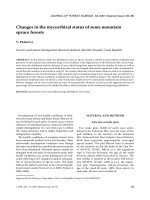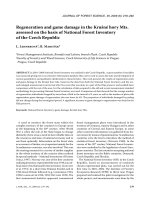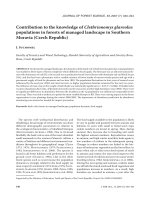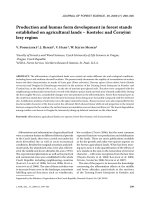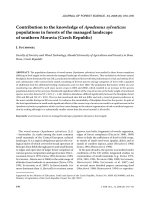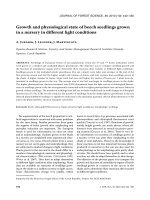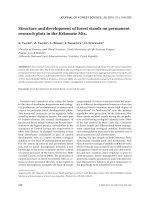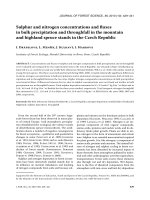Báo cáo lâm nghiệp: "Arginine and the shade tolerance of white spruce saplings entering winter dormancy" ppsx
Bạn đang xem bản rút gọn của tài liệu. Xem và tải ngay bản đầy đủ của tài liệu tại đây (635.61 KB, 7 trang )
J. FOR. SCI., 56, 2010 (2): 77–83 77
JOURNAL OF FOREST SCIENCE, 56, 2010 (2): 77–83
White spruce (Picea glauca [Moench.] Voss.) is a
shade-tolerant conifer in forest understories. Prior
studies focused on the shade-induced changes in
leaf morphology and physiology, photosynthesis,
respiration and dry matter (K, K
1979; M et al. 2008). Although arginine (2-
amino-5-guanidinovaleric acid) was first isolated
from the soluble nitrogen (N) and proteins of Picea,
Pinus, and Abies seedlings (S 1896), very lit-
tle is known about how arginine metabolism relates
to shade tolerance and to the survival of saplings
under field conditions and in N-poor forest soils.
Isotopic studies with conifers demonstrated that
arginine was synthesized de novo via the urea or
ornithine cycle and enriched the soluble N pool
by protein turnover (D 1968, 1969). e
fate of the carbon of arginine in white spruce trees
entering winter dormancy was traced to several
guanidino compounds (D 1968, 1969). e
transfer of the amidino moiety [-C(=NH)-NH
2
] of
arginine to γ-aminobutyric acid was responsible for
the formation of γ-guanidinobutyric acid. Agma-
tine is formed by the decarboxylation of arginine.
Guanidino compounds are known respiratory
inhibitors (W, B 1970; B, D-
1975, 2009).
is study investigates arginine N and its derived
guanidino compounds in white spruce saplings ha-
bituated after four years of shading under controlled
field conditions. It asks how continuous shading
redistributed amino acid N in the soluble amino
acid N pool of needles, stems with new buds and
roots in response to prior hours of sunshine and air
temperature. It demonstrates how the sequential
diversion of aspartate, glutamate and glutamine N
to arginine N and guanidino compounds correlated
with the recovery of organ biomass during the onset
of winter dormancy in a shade tolerant conifer.
MATERIALS AND METHODS
Four-year-old white spruce saplings were grown
from seed obtained from a tree breeding seed bank
at the Petawawa Forest Experiment Station, Chalk
Arginine and the shade tolerance of white spruce saplings
entering winter dormancy
D. J. D
Department of Plant Sciences, University of California, Davis, USA
ABSTRACT: Shade-tolerant white spruce saplings grown at 100, 45, 25, and 13% natural light for four years, and en-
tering winter dormancy, modified their growth habit and redistributed the total soluble N among needles, roots, and
stems with buds mainly to arginine N. Most free amino acid N was found in roots in saplings at full light, and the least at
13% light. Glutamate, glutamine, and aspartate N contributed to the accumulation of soluble arginine N. Arginine-de-
rived γ-guanidinobutyric acid, agmatine and an unidentified guanidino compound accumulated mainly in stems with
buds at 25 and 13% light. e profiling N metabolism and arginine-derived guanidino compounds extend models for
shade tolerance based mainly on photosynthesis, respiration and carbon gain.
Keywords: amino acids; arginine; guanidino compounds; nitrogen; Picea glauca; shade tolerance; winter dormancy
Supported by the Canadian Forestry Service, Ottawa.
78 J. FOR. SCI., 56, 2010 (2): 77–83
River, Ontario, Canada. Seeds originated from a local
population at 45°08'N, 81°27'W. Seedlings of uni-
form size were initially selected in 1966 to minimize
genetic variation and planted in sandy loam in an
open forest area (L 1969). Soil, light intensity,
amount of growing space and climate were control-
led factors throughout sapling development over
four years. Shade was maintained in three shelters
of lath with fibreglass screening.
e quantity of the light from dawn to dusk, meas-
ured in the shelters on clear sunny days was 13, 24,
and 45% full light. Results with a Bellani pyranometer,
which integrates total solar radiation received on a
spherical surface, showed that the percent radiation in
shelters during May to July was similar to the percent
illumination obtained from spherical illuminometers.
Differences in sapling morphology caused by envi-
ronmental factors, other than the effects of shade,
were small so that the major variable affecting sapling
growth was the quantity of light (L 1969). In
full light, the lag between monthly hours of sunshine
and air temperature (hysteresis) over the year formed
a closed path in the x, y plane (Fig. 2). Both factors
preconditioned seedlings for bud set and the onset
of dormancy. By October 13, buds on shoots already
developed for the following year (Fig. 1).
On this date, the total needles, shoots with buds,
and roots were quickly separated and harvested
between 2:30 to 3:30 pm to minimize diurnal and
translocation variations in amino acid content. Du-
plicate harvests of organ biomass were weighed fresh
and fixed immediately in the field and in 80% ethanol
(v/v). Morphological measurements were based on
the means of three saplings, one of which was not
used for biochemical analyses. e third replicate
was kept in the event that the extraction of one of
the two selected saplings was accidentally lost. e
main experimental limitation was the cost of amino
acid and guanidino analyses.
Organs were homogenized in a Waring blender
with 80% ethanol for the extraction of all Sakaguchi
and ninhydrin-positive substances. Extracts were
filtered and quickly dried at 20°C in a jet of N gas.
Residues were dissolved in a known volume of 0.2N
(Na) citrate buffer and refrigerated after adding a few
ml of chloroform to maintain asepsis and to collect
pigments which separated at the bottom of sample
vials. Free amino acids in the buffer were determined
in triplicate and quantitatively within ± 3% by the
method of B and P (1965) using a
Model 120C Beckman Amino Acid Analyzer.
Guanidino compounds (Tables 1–3) in the same
buffer were determined within ± 6% by a modi-
fication of the Amino Acid Analyzer where the
Sakaguchi reaction replaced the ninhydrin (D-
1969). Agmatine and the Sakaguchi-reactive
guanidino compound (J) are expressed as colour
equivalents based on the reaction with arginine.
e chromatographic locations of these products of
14
C--arginine are reported in earlier publications
(D 1968, 1969).
Fresh weights of whole seedlings, total needles,
roots, stems with buds, and the significance of
changes in total soluble N and arginine N contents
were evaluated using F values based on orthogonal
comparisons of equally spaced data using linear,
White spruce
4 years old
13% 25% 45% 100%
Fig. 1. e effects of shading on the morphology and redis-
tribution of biomass in shade-tolerant white spruce saplings
compared to full light
Fig. 2. Hysteresis is demonstrated in the annual relationship
between the monthly average hours of sunshine and tempera-
tures at the experimental field site. Shoot elongation ceased in
early July. e following year’s buds were visible at the end of
July. Saplings were harvested on October 13
J. FOR. SCI., 56, 2010 (2): 77–83 79
quadratic, and cubic partitions of light intensity
(S, T 1960; D 1971).
RESULTS AND DISCUSSION
e survival of a spruce seedling is estimated to
require at least 20% light transmittance (G-
2000). Survival is equivalent to about half the
growth achieved in full light. For shade tolerance, an
evergreen habit, reduced shoot biomass, and a large
root biomass are considered beneficial (B
1974). For white spruce saplings, this benefit became
evident after four years of shading (Fig. 1).
By October, full and 45% light produced the high-
est total biomass, the most robust saplings, the
highest density of needles, and most side branches
(Fig. 1, Tables 1–3). Leader-shoot height and needle
length were greatest at 45% light. At 13% light, total
sapling biomass was less than one fourth of that of
full and 45% light. Roots now accounted for nearly
half of the sapling biomass. Stems with buds had the
highest biomass density (g.cc
–2
).
Orthogonal comparisons over shade treatments
for the response of total soluble (N.g
–1
) f wt gave
highly significant F values (Tables 1–3). Most solu-
ble N was distributed to roots (full light, Table 2),
followed by needles (45% light, Table 1), and stems
with new buds (25% light, Table 3). Least soluble
N was recovered from roots (25 and 13% light, Ta-
ble 2), needles (13% light), and stems with new buds
(full light). e greatest decline occurred in roots
and needles. In roots, the soluble N fell from 870
(full light) to 86 µg N (13% light, Table 2). In leaves
it fell from 770 (45% light) to 173 µg N (13% light).
Table 1. Needle parameters and the composition of free amino acid N and guanidino compounds in the soluble N pool
of four-year-old white spruce saplings exposed to continuous natural light and shading under field conditions (% total
soluble N)
Treatment
Natural 45% 25% 13%
Amino acid N
Glutamate** 11.1 6.7 6.6 5.7
Glutamine** 12.1 20.8 21.0 9.7
Aspartate 1.1 0.7 0.5 0.8
Asparagine 6.9 3.9 7.7 4.8
Arginine* 4.0 7.2 7.9 15.1
Ornithine 0.5 0.3 0.4 0.8
Proline 3.1 5.3 3.3 2.9
Glycine 1.4 1.2 0.9 1.3
γ-Aminobutyrate 13.4 13.3 8.9 11.4
Subtotal % N 53.6 59.4 57.2 52.5
µg soluble N.g
–1
/f wt* 481.0 770.0 484.0 173.0
Guanidino compounds arginine colour equivalents/g f wt
γ-Guanidinobutyrate* 1.3 3.3 9.4 5.6
Agmatine 0.8 0.3 0.9 5.4
Unidentified J 0.9 1.1 5.2 2.9
Total colour equivalents* 3.0 4.7 15.5 13.9
needle biomass
Needle length mm* 12.1 14.0 11.0 9.3
% g f wt* 24.8 26.1 50.0 34.5
Total g f wt/sapling** 106.5 105.3 46.0 23.3
Guanidino compounds are expressed as arginine equivalents based on the colour reaction with the Sakaguchi reagent.
F values significant at 1** and 5*%; f wt – fresh weight
80 J. FOR. SCI., 56, 2010 (2): 77–83
Arginine N originates mainly from glutamic acid,
glutamine, and aspartic acid (D, S
1983). Glutamic acid N is a precursor for glutami-
ne N. e latter is a main translocated form of solu-
ble N. Aspartic acid N is required for the synthesis
of argininosuccinic acid, which is a transient and im-
mediate precursor for the N in the guanidino moiety
in arginine. It is also a precursor for asparagine.
In response to shading, the percent N changes for
glutamic acid, glutamine and arginine N in all organs
were highly significant (Tables 1–3). Glutamic acid
N declined in all organs. Glutamine N declined in
needles and stems with buds but increased in roots
(25 and 13% light). Arginine N accumulated in all
organs. Percent arginine N was greatest in roots and
in stems with new buds. At 13% light, glutamic acid,
glutamine, aspartic acid and arginine N contributed
76% to the total soluble N of roots. Changes in as-
partic acid N were not significant.
Protein turnover or synthesis either added to or
subtracted arginine N in the soluble N pool. e
accumulation of arginine N indicated that reduced
light may have limited the synthesis of N-rich storage
proteins. Proteins are turned over in the following
spring to provide amino acid substrates and energy
for growth and development (D 1969).
In white spruce shoots, respiration declines from
a high in June to a low in late August (C 1961).
When shoot elongation ended in mid-July at Peta-
wawa, arginine N started to accumulate in terminal
shoots (D 1968). By early September and
after the first frost, the synthesis of γ-guanidinobu-
tyric acid and other guanidino compounds from
[UL-
14
C]--arginine was already in progress.
e transfer (transamidination) of the amidino
moiety of arginine to γ-aminobutyric acid is re-
quired for the synthesis of γ-guanidinobutyric acid
(D 1969). e decarboxylation of arginine
Table 2. e responses of free amino acid N and guanidino compounds in the soluble N pool of the roots of four-year-
old white spruce saplings exposed to continuous natural light and shading under field conditions (% total soluble N). is
is only place where traces (t) were observed
Treatment
Natural 45% 25% 13%
Amino acid N
Glutamate* 24.5 36.6 21.9 18.5
Glutamine** 4.6 12.0 18.8 24.2
Aspartate 4.5 5.0 6.6 3.4
Asparagine 6.6 8.1 2.9 13.6
Arginine* 22.6 8.4 10.9 30.0
Ornithine 0.3 0.2 2.2 0.5
Proline 1.2 1.6 0.9 1.0
Glycine 0.5 0.7 1.3 1.3
γ-Aminobutyrate 2.6 1.4 1.1 3.0
Subtotal % N 67.4 74.0 66.6 95.5
g soluble N.g
–1
/f wt** 870.0 655.0 92.0 86.0
Guanidino compounds arginine colour equivalents/g f wt
γ-Guanidinobutyrate* 14.1 7.0 14.4 40.6
Agmatine 6.4 9.0 2.9 5.7
Unidentified J t t 1.0 t
Total colour equivalents 20.5 16.0 18.3 46.3
root biomass
% g f wt 61.5 58.8 38.0 45.2
Total g f wt/sapling** 106.5 105.3 46.0 23.3
Guanidino compounds are expressed as arginine equivalents based on the colour reaction with the Sakaguchi reagent.
F values significant at 1** and 5*%; f wt – fresh weight
J. FOR. SCI., 56, 2010 (2): 77–83 81
accounts for the formation of agmatine. Although
the structure of compound J remains unknown, its
chromatographic properties indicated that it is a
more basic compound than arginine. Another gua-
nidino compound in spruce, α-keto-δ-guanidinova-
leric acid (D, R 1966), is formed
by transamination and decarboxylation, as distinct
from transamidination. Only traces were detected
in full light.
With increasing shade, total guanidino compounds
accumulated in stems with new buds followed by
roots and needles (total colour equivalents, Table 3).
γ-Guanidinobutyric acid (all organs) and agmatine
(stems with buds) showed a significant response
to shading. e inhibitory properties of guanidino
compounds and their differential distribution in sap-
lings indicate that not all organs may have become
dormant at the same time. [1-
14
C]-Guanidinoacetic
acid, a candidate for one of the trace unidentified
guanidino compounds, when added to excised shoot
primordia of white spruce in October, inhibited res-
piration (D 2009).
In spring, the prior accumulation of free arginine
spares energy as adenosine triphosphate (ATP) for
Table 3. Size parameters and the responses of free amino acid N and guanidino compounds in the soluble N pool of
stem and buds of four-year-old white spruce saplings exposed to natural light and shading under field conditions in
mid-October
Treatment
Stem and Buds
Natural 45% 25% 13%
Amino acid N % total soluble N
Glutamate** 10.5 6.1 4.2 4.3
Glutamine** 29.7 42.4 22.2 20.4
Aspartate 1.3 0.7 0.8 1.0
Asparagine 4.0 3.9 3.7 3.1
Arginine* 17.1 28.2 52.1 47.7
Ornithine 0.3 0.1 0.1 0.5
Proline 4.5 2.9 1.9 2.5
Glycine 1.1 0.6 0.6 0.9
γ-Aminobutyrate 6.8 1.7 2.4 4.8
Subtotal % N 75.3 86.6 88.0 85.2
µg soluble N.g
–1
/f wt** 352.0 513.0 648.0 498.0
Guanidino compounds arginine colour equivalents/g f wt
γ-Guanidinobutyrate* 40.9 104.4 299.0 175.8
Agmatine* 23.5 50.7 161.3 90.9
Unidentified J 3.3 0.9 3.4 16.8
Total colour equivalents* 67.5 156.0 463.7 238.5
stem and bud biomass
Shoot height cm* 7.4 9.8 6.5 6.4
Shoot density (g/cc
–3
)* 3.7 3.9 4.1 5.9
Mid shoot dia. mm* 2.6 2.3 1.7 1.3
% g f wt/sapling 13.6 15.2 12.0 20.2
Total g f wt/sapling** 106.5 105.3 46.0 23.3
Guanidino compounds are expressed as arginine equivalents based on the colour reaction with the Sakaguchi reagent.
F values significant at 1** and 5*%; f wt – fresh weight
82 J. FOR. SCI., 56, 2010 (2): 77–83
the de novo synthesis of arginine when ATP is needed
for rapid bud growth and cambial development (D-
1969; A 1977). Arginine provides N
for the synthesis of other amino acids some of which
are precursors for growth hormones, polyamines,
and nitric oxide (NO) (D, S 1983;
D, P 2002). NO maintains metabolic
homeostasis and protects against oxidative and ni-
trosative damage at high light intensities (D
2002; C et al. 2008).
In trees, the cessation of growth and bud set,
induced by short days, is regulated by a (CO/FT)
regulatory module for two genes, CONSTANS (CO)
and FLOWERING LOCUS T (FT) (B et al.
2006). e tracking of hours of sunshine and air tem-
perature (Fig. 2) would comprise an integrated envi-
ronmental signal for the CO/FT regulatory module to
initiate enzymatic changes in N metabolism required
for sapling habituation and over-winter survival.
Spruce saplings in this study were juvenile and the
transition of vegetative buds to male or female cones
was not yet a factor for FT expression.
In Douglas-fir trees, arginine and guanidino
compounds have been used as biomarkers to
predict growth and the optimal time for adding
fertilizers (V D D, W 1977).
Phloem was more useful than root analyses in
determining the tree nutrient status. Arginine
and guanidino compounds accumulated with the
nitrate fertilizer treatment. In the next year, seed
cone production was elevated 2 to 7 times (E,
MM 1970).
CONCLUSIONS
Light intensity, photoperiod, and temperature
changes were tropistic factors contributing to the
redistribution of amino acid N from needles to or-
gans having meristems entering winter dormancy.
More than a century after the discovery of arginine
in conifers we now know that arginine N contributes
to the seasonal and metabolic response to reduced
light by a shade-tolerant spruce. Physiological changes
in N metabolism are postulated as being under the
genetic control of regulatory modules controlling the
cessation of growth, and years later during maturity
to flowering and viable seed production. Arginine-
derived guanidino compounds as respiratory inhibitor
respiratory inhibitors contributed to dormancy and
increased with shading. e concentration of solu-
ble N in arginine may spare photosynthates for the
synthesis of carbon-rich secondary products which
may protect against pathogens, insects, and frost da-
mage. During the breaking of dormancy in spring, the
removal of inhibitory guanidino compounds provides
sources of N for the renewed synthesis of arginine.
Arginine N and guanidino compounds may have util-
ity as physiological biomarkers in tree improvement
and breeding programs where soils are limited by the
availability of N.
Acknowledgements
K L provided seedlings from his shade
experiment at Petawawa. G S assisted
in sampling procedures and in the operation of the
Amino Acid Analyzer. Supported by McIntyre-Sten-
nis and NASA (NAG 9-825) funds at University of
California in Davis. C V of the Bio-
metrics Branch of the Forestry Service in Ottawa
provided the statistical evaluation.
R ef er en c es
A D. (1977): Cellular Energy Metabolism and Its
Regulation. New York, Academic Press.
B J.V., P J.A. (1965): Accelerated chroma-
tographic analysis of amino acids commonly found in
physiological fluids on a spherical resin of specific design.
Analytical Biochemistry, 13: 265–280.
B R.G.S., D D.J. (1975): Some recent aspects
of nitrogen metabolism. In: D P.J. (ed.): Historical
and Recent Aspects of Plant Physiology. Ithaca, Cornell
University Press: 152–225.
B W.D. (1974): Arctic and alpine vegetation; plant
adaptation to cold summer climate. In: I J.D., B
R.G. (eds): Arctic and Alpine Environments. London,
Methuen: 403–443.
B H., H T., C-C L., B
A.M., J S., S S.H., N O. (2006): CO/FT
regulatory module controls timing of flowering and seasonal
growth cessation in trees. Science, 312: 1040–1043.
C J. (1961): Photosynthesis and respiration in white
spruce and balsam fir. Syracuse University Technical Pub-
lication, 85: 1–72.
C F.J., C M., F-O A., V
R., P J.M., C A., B-M J.C.,
A M., D R L.A., B J.B. (2008): Metabolism
of reactive nitrogen species in pea plants under abiotic stress
conditions. Plant Cell Physiology, 49: 1711–1722.
D D.J. (1968): Nitrogen metabolism of Picea glauca. I.
Seasonal changes of free amino acids in buds, shoot apices
and leaves, and the metabolism of uniformly labeled
14
C--
arginine by buds during the onset of dormancy. Canadian
Journal of Botany, 46: 909-919.
D D.J. (1969): Nitrogen metabolism of Picea glauca. IV.
Metabolism of uniformly labeled
14
C--arginine, [carbamyl-
14
C]--citrulline, and [1,2,3,4-
14
C]-γ-guanidinobutyric acid
J. FOR. SCI., 56, 2010 (2): 77–83 83
during diurnal changes in the soluble and protein nitrogen
associated with the onset of expansion of spruce buds.
Canadian Journal of Biochemistry, 47: 771–783.
D D.J. (1971): Free amino acids as affected by light
intensity and the relation of responses to the shade-toler-
ance of white spruce and shade intolerance of jack pine.
Canadian Journal of Forest Research, 1: 131–140.
D D.J. (2002): Stress-induced nitric oxide and adap-
tive plasticity in conifers. Journal of Forest Science, 48:
281–291.
D D.J. (2009): Transamidination-based recycling of the
respiratory inhibitor [1-14C]- guanidinoacetic acid to 14C-
glycine in white spruce shoot primordia entering winter
dormancy (Picea glauca Moench Voss). Trees – Structure
and Function (in press).
D D.J., R R.G. (1966): e occurrence and
role of α-keto-δ-guanidinovaleric acid in white spruce Picea
glauca (Moench.) Voss. Canadian Journal of Biochemistry,
44: 141–143.
D D.J., S F.C. (1983): Nitrogen metabolism.
Chapter 2. In: S F.C., B R.G.S. (eds): Plant
Physiology: A Treatise. New York, Academic Press Inc.:
55–265.
D D.J., P M. (2002): Nitric oxide and reactive
nitrogen oxide species in plants. Biotechnology Genetic
Engineering Reviews, 19: 293–337.
E L.F., MM E.E. (1970): Nitrogenous substances
associated with differential cone production responses of
Douglas fir to ammonium and nitrate fertilization. Canadian
Journal of Botany, 48: 2169–2177.
G S.C. (2000): Ecophysiology of Northern Spruce
Species: e Performance of Planted Seedlings. Ottawa,
National Research Council Research Press: 409.
K P.J., K T.T. (1979): Physiology of Woody
Plants. New York, Academic Press.
L K.T. (1969): Growth of tree seedlings as affected by
light intensity. IV. Black Spruce, White Spruce, Balsam Fir,
and Eastern White Cedar. Ottawa, Department of Fisher-
ies and Forestry, Canadian Forestry Service: Publication
No. 1256.
M M., Y Y., N T. (2008): Large-
scale canopy opening causes decreased photosynthesis in
the sapling of shade-tolerant conifer, Abies veitchii. Tree
Physiology, 19: 137–145.
N A.W. (1959): Interrelations of ornithine, citrulline
and arginine in plants. Society Experimental Biology Sym-
posium XIII: 193–209.
S E. (1896): Über die beim Umsatz der Proteinstoffe
in den Keimpflanzen einiger Coniferen Arten entstehanden
Stickstoffverbindungen. Hoppe-Seyler’s Zeitschrift für
Physiologische Chemie, 22: 435–448.
S R.G.D., T J.H. (1960): Principles and Procedures
of Statistics. New York, McGraw-Hill.
V D D R., W J.E. (1977): Variations in
total soluble nitrogen concentrations in response to fertili-
zation of Douglas-fir. Forest Science, 2 3: 134–142.
W S.B, B W.D. (1970): Effects of guanidine
inhibitors on mung bean mitochondria. Plant Physiology,
46: 21–24.
Received for publication May 26, 2009
Accepted after corrections September 22, 2009
Corresponding author:
Prof. D J. D, University of California, Department of Plant Sciences, MS 6, One Shields Avenue,
Old Davis Road, Davis, CA, 95616, USA
e-mail:
